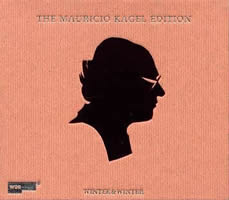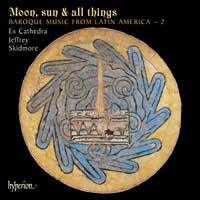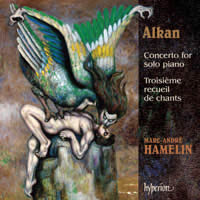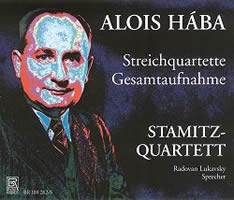A Late Last-But-Not-Least List
|
Grant Chu Covell [January 2008.] This miscellany covers a handful of worthy 2007 releases, with a few having arrived in 2006. There’s yet another queue of probably great discs awaiting attention when I clear the decks for a proper listen. The so-far-neglected lot includes Sub Rosa’s limited edition CD + DVD with Ferrari’s Didascalies and col legno’s complete Aperghis Récitations with Donatienne Michel-Dansac. If you were to ask me about 2007’s best-of items, two spring to mind: Tharaud’s Couperin on Harmonia Mundi HMC 90195 and Langgaard’s Antikrist on Dacapo 6.220523-24 (2 SACDs) or Dacapo 2.110402 (1 DVD). Tharaud’s Couperin has become a habit I indulge close to daily. “The Mauricio Kagel Edition.” Mauricio KAGEL: Pandorasbox, bandoneonpiece (1960/…); Tango Alemán (1977/78); Bestiarium (1974/75); (Hörspiel) Ein Aufnahmezustand (1969); Ludwig van (1969). Winter & Winter 9210 128-2. 2CDs, 1 DVD. Limited numbered edition of 3000 (http://www.winterandwinter.com/). Distributed in the US by Allegro Music (http://www.allegro-music.com/). Preaching to the choir: The Kagel fan who doesn’t already own this must be in a coma. Anyone who cares about 20th-century music absolutely has to have it. Winter & Winter brings us a typically attractive item: three discs and an illustrated 60-page English-German booklet timed for Kagel’s 75th birthday (Dec. 24, 2006). The first CD features three somewhat conventional concert pieces for instruments, including the composer performing, Kagel having re-edited and remastered these recordings and the video from WDR masters in 2006. Kagel lurches through a solo bandoneon piece, Pandorasbox, bandoneonpiece, delivers the nonsense vocals to a grimly whimsical Tango Alemán (with requisite bandoneon, violin and piano), and participates as one of three bird-call virtuosi for a lengthy three-part Bestiarium. Witty, playful and contradictory, Kagel’s domain emerges splendidly. Down with serialism’s hegemony! Introspection is where it’s at! The second CD will prove somewhat challenging for the non-German speaker. Hörspiel is a musical composition intended for radio broadcast, generally including manipulated field recordings and sound effects. Theatre, poetry and fantasy are key ingredients, to which Kagel — a primary instigator in this genre — adds Surrealism, Dada and fistfuls of the absurd. Ein Aufnahmezustand comprises seven English-titled parts: Speak softly, Lullaby, Spinning top, Acoustic lessons for children, Ethnophonation, Excursus about the love in the Christian theology, Onomatopoeia and musical pictures. Typically self-referential, Ein Aufnahmezustand is about making a piece for radio. The set’s high point, a reissue of Kagel’s classic 1969 film, Ludwig van, has also been released independently as Winter & Winter 915 006-7. A bit overlong at 90 minutes, the “report” strings together preposterous vignettes about a character named Beethoven who was poised to celebrate a really big birthday the following year. Taken as an historical artifact — the filming took place in 1969 — it’s fun to see Bonn and vinyl records being made. Several images endure: the music room papered with Beethoven scores, and the bathtub filled with Beethoven busts. Other scenes remind one of Monty Python: the purported last living descendant standing in a field, pretentious talking heads speculating on whether Beethoven is misused, parodies of WDR’s onscreen newsreaders, a naked pianist wired to measuring apparatus in order to quantify the artistic experience. A visit to the Beethovenhaus provides a look at the remnants of genius: ear trumpets, beds, chamber pots, posthumous commemorative medals, etc. When hundreds of scores tumble out of a closet we realize that the composer’s legacy endures. At the end musicians and zoo animals intermingle. W&W’s booklet includes production stills and credits that include Joseph Beuys, Dieter Roth (or Diter Rot as he called himself at the time) and others. In December 2006, Naxos released a single Kagel disc with Szenario (1981-82), Duodramen (1999) and Liturgien (1989-90) on Naxos 8.570179. The casual listener might feel that Kagel has descended to convention in scoring for singers and orchestra. Not so! Combining string orchestra with tape, with its atmospheric effects and barking dogs, Szenario can also serve as soundtrack to Le chien andalou. In Duodramen a soprano-baritone pair offer love songs between unusual historical match-ups: Indira Gandhi and Casanova, Henry Ford and Cosima Wagner, and so on. Liturgien collages traditional texts to religious music to emphasize their kinship.
“Moon, sun & all things: Baroque Music from Latin America, Vol. 2.” Var. composers and works. Ex Cathedra, Jeffrey Skidmore (cond.). Hyperion CDA67524, CD or SACD (http://www.hyperion-records.co.uk/). Distributed in the US by Harmonia Mundi (http://www.harmoniamundi.com/). Here’s a magical release of luminescent choral music from Latin America. Accompanying European missionaries across the ocean, Baroque music took on a life of its own, blending with local instruments (rainsticks, tambourines) and indigenous languages. The program consists in large measure of a Vespers service with an opening Response, three Psalm settings, a Hymn and Magnificat interspersed with popular songs in Spanish and Nahuatl (Aztec). Two anonymous works, Hanacpachap cussicuinin and a beautiful Dulce Jesús mío, frame the service. The boldest pieces are by Juan de Araujo, including a Dixit Dominus and a vibrant ¡Ay, andar! wherein the troupe cuts loose. Another favorite is Diego José de Salazar’s antiphonal ¡Salga el torillo hosquillo!, which tells the story of a rampant bull (rather strange for a mass symbolism notwithstanding). European imports include Domenico Zipoli’s Beatus vir and Ave maris stella. Ex Cathedra performs beautifully and Hyperion’s balance and sound are nothing short of extraordinary. Perhaps the greatest American composer of his time, Araujo’s (1646-1712) enormous output commands a number of genres. His family relocated from Spain to Peru when he was a child. By 1672 he was choirmaster at the Cathedral in Lima. From 1680 to the time of his death, he directed 35 musicians at what is now the cathedral at Sucre, Bolivia. “L’or et l’argent du Haut-Pérou: L’oeuvre de Juan de Araujo,” with La Maîtrise Boréale and L’Ensemble Elyma led by Gabriel Garrido (K617 038), presents an entire disc of choral music wherein soloists and massed voices emerge and retreat, sometimes in mid-phrase, to maximize the texts’ potency. Araujo’s repeated couplets and refrains often contain subtle duple and triple shifts to conform to the verses’ syllables. Older Ensemble Elyma releases (O/P) plumb the trove of Latin American Baroque music. “Mission San Francisco Xavier,” (K617 111) organizes a representative program which may have been used to celebrate St. Francis Xavier. All the works are attributed to anonymous 18th century indigenous (Bolivian) composers who came into contact with Jesuits who imported European music and forms. Dulce Jesús mío appears on this program, as well as a solemn mass attributed to an unknown Franciscu Varayu. More Araujo appears on the recent “Bolivian Baroque Vol. 2, Music from the Missions and La Plata,” with Florilegium & Arakaendar Bolivia Choir (Channel Classics CCS SA 24806). The European imports include sonatas from I. Balbi and P.A. Locatelli, and a mass by G.B. Bassani. The notes, which don’t really mesh with the program’s flow, must be perused several times to learn anything about the individual works’ circumstances. Araujo’s two villancicos, Cayósele al Alba and Si el Amor se quedare dormido, shine. Despite being recorded at the music’s spiritual home in Bolivia, Florilegium displays less panache than Ex Cathedra’s London tapings.
Charles-Valentin ALKAN: Concerto for solo piano, Op. 39, Nos. 8-10 (1857); Troisième recueil de chants, Op. 65 (1857-70). Marc-André Hamelin (pno). Hyperion CDA67569 (http://www.hyperion-records.co.uk/). Distributed in the US by Harmonia Mundi (http://www.harmoniamundi.com/). Hardcore piano fans need no introduction to Alkan. Others may know him as the composer crushed to death by a toppling bookcase. Among Alkan’s famously difficult music for solo piano lurk the Douze études dans tous les tons mineurs, Op. 39, containing a Symphonie (études 4 to 7) and a Concerto (nos. 8-10). Displaying rather more than mere pyrotechnics, the concerto’s first movement is an involved sonata allegro lasting nearly a half-hour. All three movements occupy close to 50 minutes. The work’s extravagance extends beyond its finger-busting demands into complex structures requiring mental agility. Hamelin is the Man, as this obscure repertoire’s followers know from his Alkan symphony recording (Hyperion CDA67218). The Concerto thrills. Distinctions between tutti and soli are precise. After the initial orchestral statements, the piano’s solo entrance suggests languid Chopin. Peculiar chords and registrations seemingly create orchestral or, at the very least, blatantly non-pianistic balances. Dense five-note chords are common, with frequent unresolved sevenths and ninths looking ahead to Scriabin and Ravel, despite the Chopin-Liszt milieu. We may occasionally catch whiffs of later decades’ eccentrics, e.g., Sorabji or Ornstein. The morose central Adagio edges towards Rachmaninoff; the concluding, rondo-like Allegretto alla barbaresca exudes a Turkish perfume. Alkan didn’t always target the impossible, witness the delicate six-movement Troisième recueil de chants modeled on Mendelssohn. With his formidable powers, Hamelin reveals an Alkan less esoteric than is commonly assumed. Alois HÁBA: Complete String Quartets. Stamitz-Quartett: Bohuslav Matousek, Josef Kekula (vlns), Jan Peruska (vla), Vladimir Leixner (vlc); Radovan Lukavsky (speaker). Bayer Records BR 100 282-5 CD (http://www.bayermusicgroup.de/). 4CDs. Distributed in the US by Qualiton (http://www.qualiton.com/). This four-disc set collects Hába’s 16 string quartets — ten written in alternate tuning systems — along with two additional pieces: Six Compositions for Sixth-tone Harmonium or String Quartet, Op. 27, and the Op. 101 Tagebuch-Notizen for quartet and Sprechstimme. Nos. 1, 7, 8, 9, 13 and 15 employ standard intonation. Nos. 2, 3, 4, 6, 12 and 14 are quarter-tone works. Five, 10 and 11 are in sixth-tones, and the final quartet, no. 16, is in fifth-tones. For Hába, alternate scale systems weren’t merely about color and piquant flavors. His carefully thought-out theories and systems resulted in expressive, if often difficult and angular, music. Written throughout Hába’s long career, the quartets fall into groups. Nos. 1 through 5, spanning 1919 to 1923, breathe Janacek and Dvorak with sparkly folk rhythms and gestures over bright oompah accompaniments. The quarter- or sixth-tone tunings’ strangeness evaporates immediately. At one point, thinking he would forever devote himself to alternate scales, Hába disowned his 1919 First, a lushly tonal four-movement composition worthy of comparison with Schoenberg’s windier First. The quarter-tone Third (1922) is dedicated to Hindemith who prided himself on nailing the eccentric intonation when his quartet gave the work’s premiere. After a long hiatus, the terse and grittily energetic No. 6 appeared in 1950. Like Webern, Hába wastes no notes. Nos. 7, 8 and 9 (1951-52) revisit standard intonation. The folksy Seventh (1951) includes Moravian folk tunes: hence its subtitle, “Christmas.” After the sixth-tone Tenth in 1952, there’s a gap until the next, the sixth-tone Eleventh in 1958. These last quartets are concise and lean. The 1961 Thirteenth employs a 12-tone row. Curiously, the Fourth through the Thirteenth use similar fast-slow-fast, three-movement structures. Fidgety, aphoristic statements dominate, especially in the scant six-minute, five-movement Fifteenth (1964). The cycle’s last dates from 1967: the gentle, sunlit rocking of the fifth-tone Sixteenth’s first movement illuminates the seventh movement’s strange outcroppings. In these 1996 recordings, the Stamitz play precisely, as in their effortless command of the quarter-tone Fourth’s bustling, manic energy as it winds its way through the 24-pitch octave. The “in between” tones sound less pronounced with the Stamitz than in other Hába quartet recordings: 1978 tapings of nos. 7, 8, 13, 15 and 16 live on Le Chant du Monde / Praga Productions PR 255 005 with the Suk Quartet (formerly the Novak Quartet, with one member in common), or the Novak’s Quartet’s original formation in nos. 11, 12, 15 and 16, recorded in the 1960s on Supraphon’s three-disc Hába Centenary set (11 1865-2 913). While the Novak — the premiering quartet — exaggerated somewhat, these older releases reveal great passion.
[More Grant Chu Covell]
[Previous Article:
Haydn, Carter and Mahler at the BSO]
[Next Article:
Mostly Symphonies 6. / Naxos Bowl 2.]
|



